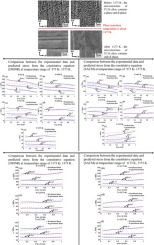Materials Today Communications ( IF 3.8 ) Pub Date : 2020-03-06 , DOI: 10.1016/j.mtcomm.2020.101053 Menglan Shen , Yuanming Huo , Tao He , Yong Xue , Wanbo Yang , Yujia Hu , Xinxing Jiang

|
Different constitutive modeling methods lead to different prediction accuracy of stress-strain relationships for hot metal forming. The aim of this work is to establish constitutive model using two methods of double multiple nonlinear regression model (DMNR) and strain-compensated Arrhenius-type constitutive model (SACM) to describe the material flow behaviour of TC16 titanium alloy under hot compression in the strain rate range of ∼ and temperature range of ∼ . A comparative study has been conducted on the prediction capability of DMNR model and SACM model under different temperature ranges, and their prediction accuracy was quantified by using standard statistical parameters such as correlation coefficient (), average absolute error () and roof mean square error (). The results showed that the DMNR model has a better prediction accuracy to describe the stress-strain relationship than SACM model at temperature range of ∼ . It indicates that DMNR model is more suitable in a wider range of deformation temperature. When the constitutive models of TC16 titanium alloy were developed at temperature range of ∼ , SACM model has more excellent predictability than DMNR model. It indicates that SACM model is more suitable to describe the stress-strain relationships in a narrow range of deformation temperature.
中文翻译:

TC16合金高温变形中两种本构建模方法的比较。
不同的本构建模方法导致铁水成形的应力-应变关系的预测精度不同。这项工作的目的是使用双重多重非线性回归模型(DMNR)和应变补偿的Arrhenius型本构模型(SACM)的两种方法建立本构模型,以描述TC16钛合金在热压缩状态下的材料流动行为。的速率范围 〜 和温度范围 〜 。对DMNR模型和SACM模型在不同温度范围内的预测能力进行了比较研究,并使用标准统计参数(如相关系数(),平均绝对误差()和屋顶均方误差()。结果表明,在温度范围内,DMNR模型比SACM模型具有更好的预测应力-应变关系的预测精度。 〜 。这表明DMNR模型更适用于更宽的变形温度范围。当TC16钛合金的本构模型在0〜0℃的温度范围内建立时。 〜 ,SACM模型比DMNR模型具有更好的可预测性。这表明SACM模型更适合描述变形温度窄范围内的应力-应变关系。


























 京公网安备 11010802027423号
京公网安备 11010802027423号